

Vol. 40(Issue 43) Year 2019. Page 11
YAKIMENKO, Marianna 1; ZHERTOVSKAJA, Elena 2 & GORELOVA, Galina 3
Received: 07/09/2019 • Approved: 10/12/2019 • Published 20/12/2019
ABSTRACT: The relevance of this study is caused by a number of existing theoretical and applied gaps in the implementation of a sustainable approach towards the development of tourism. The purpose of this article is to systematize existing studies, develop a model for sustainable development of a local tourist recreational complex. The leading methods to study this problem are methods of cognitive methodology based on a graphical and set-theoretic description of systems. As a result of the study, a system of factors for the sustainable development of a local tourist recreational complex was developed, which allowed creating a simulation model of the sustainable development of tourism systems. |
RESUMEN: La relevancia de este estudio es causada por una serie de lagunas teóricas y aplicadas existentes en la implementación de un enfoque sostenible hacia el desarrollo del turismo. El propósito de este artículo es sistematizar los estudios existentes, desarrollar un modelo para el desarrollo sostenible de un complejo recreativo turístico local. Los principales métodos para estudiar este problema son los métodos de metodología cognitiva basados en una descripción gráfica y teórica de conjuntos de sistemas. Como resultado del estudio, se desarrolló un sistema de factores para el desarrollo sostenible de un complejo recreativo turístico local, que permitió crear un modelo de simulación del desarrollo sostenible de los sistemas turísticos. |
Most countries of the modern world consider tourism as an important industrial sector of the world economy. The results of numerous studies confirm not only the positive contribution of tourism to the national economies but also reveal the presence of undesirable economic, socio-cultural and environmental consequences. Therefore, the creation of conditions for ensuring the sustainable development of tourism is considered to be an important problem nowadays.
On the one hand, the factors of globalization are transforming the global space, defining new development imperatives that are subsequently projected onto national economies. Thus, considering the issues of ensuring the sustainability of tourism has long been an urgent issue worldwide: the fact that 2017 was declared by the UN as the Year of Sustainable Tourism confirms the importance of this challenge.
On the other hand, it should be recognized that the development and implementation of a complex approach to the tourism sector from a position of sustainable development should be adapted to the specific conditions of the local territory. This question, perhaps, is interesting to study, both from the position of theoretical and practical aspects.
Tourism is a quite specific field of research, due to the multidimensional nature of the processes occurring in it and their interconnectedness with environmental factors, as a result of which everything that happens should be considered collectively. We can also talk about the lack of sufficient quantitative information about the dynamics of processes, which in turn determines the need to use qualitative analysis of such processes.
Therefore, the search for innovative approaches and methods for studying the tourism development issues in the context of the concept of sustainable development is relevant and determines the given research problem.
In this study, the authors set the goal of working out a cognitive model for the development of a local tourist recreational complex focused on sustainable development.
The main objectives of the study are determined as the following:
- systematization and assessment of existing methodological developments in the field of tourism development sustainability evaluation;
- development of a system of factors for assessing the sustainability of the development of a tourist recreational complex;
- formalization of relations between factors determining the sustainability of the development of a tourist recreational complex and model building;
- conducting cognitive modeling based on the scenario approach and impulse modeling (this is an investigation of the possible development of processes in the system by impulse modeling, i.e. the transition from previous studies of the system statics to the study of its dynamics);
- identification of possible scenarios for sustainable development of the local tourist recreational complex.
The analysis of the problem and modern research results conducted both by research centers (individual scientists), government organizations and international communities allows us to conclude that sustainability remains one of the urgent issues for the tourism sector, which is primarily determined by the versatility of possibility to study this concept (Fig. 1).
Figure 1
Current trends in sustainability
research for the tourism industry
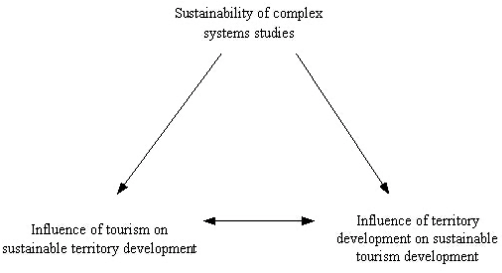
According to J. Casti (Casti, 1982), the term ‘sustainability’ is highly ambiguous in the literature, since it is used to determine various things from classic Lyapunov’s sustainability to organizational sustainability.
On the one hand, studying the stability of complex systems makes it necessary to use the methods of system analysis and the modern methods of data mining based on them, and certain tools.
Thus, there are two main classes of problems distinguished in the sustainability studies: “classic” sustainability and “structural” sustainability of systems, each of which can be studied using different mathematical models of the internal or external description (Gorelova, et al, 2006).
Within the framework of “classic” sustainability (the formulation of sustainability problems in the internal description (Barbashin, 1967)), the influence of external factors on the unchanging system and the behavior of its trajectories in the ε-neighborhood of the attraction region are studied.
The study of structural sustainability is associated with possible changes in the system itself, which can lead to sharp qualitative changes in the further behavior of the system.
For tourism, the usual mode of functioning is far from equilibrium; therefore, the study of sustainability through “structural sustainability” seems to be a more relevant approach.
On the other hand, we can talk about the existence of a question related to the study of the impact of tourism development on the sustainable development of the local territory. In this direction, the study of super tourism, which requires a reinterpretation of the key principle in tourism, is becoming relevant that means an increase in the number of territory visitors, the implementation of which often does not allow taking into account factors of the economic, social and environmental load on the territory. The importance and significance of this issue were confirmed by its discussion at the UNWTO World Tourism Ministers Summit in 2017 as a part of the Travel Market in London and within the agenda of the Tourism Convention under ITB-2018 in Berlin.
The question that was posed within the framework of this research is related to another possible direction for study, namely, the identification of the impact of territorial development on the sustainable development of tourism.
Today we can talk about the presence of a significant number of studies of sustainability in tourism. Even listing of only the directions of issues raised is a difficult task. Among the main areas of research, we highlight the issues related to the definition of the term “tourism sustainability”. The existing discussions can be reduced to the conclusion reached by Sharpley (Sharpley, 2000) that all definitions fall into the two categories: tourism-oriented and the ones that consider its maintenance as an economic activity and determine tourism as an element of sustainable development policy.
The consideration of tourism can be called “traditional” from the perspective of sustainable development through the prism of economic, social or socio-cultural, and environmental aspects (Mowforth & Munt, 1998).
The question of the differences between sustainable tourism development and sustainable tourism is raised, for instance, by Butler (Butler, 1993).
Let us also pay attention to the position of McCool, Butler, Buckley, Weaver & Wheeller (McCool, et al, 2013), who argue that the modern concept of sustainable tourism development is characterized by conceptual uncertainty and declarativeness, while certainty and practical expression are needed.
We cannot disagree with this statement and can conclude that it is necessary not only to formalize the definition of sustainable tourism development but also to identify factors contributing to this, as well as indicators necessary to assess the level of sustainability in the organization of the process of managing the area for a particular territory.
First of all, we specify that in this study by “tourism” we mean a tourist recreational complex as a part of the general economic complex of a territory within specific administrative boundaries (which determines the management system), with a certain potential, primarily based on tourist resources and necessary infrastructure facilities (Yakimenko, et al, 2018).
By introducing the concept of “tourist recreational complex” we formalize the category of “tourism” as an object of management for a specific territory and a specific management system. We consider it inadmissible to raise the issues of tourism management, and, moreover, the issues of sustainable development without taking into account the indicated criteria. For example, in Russia, each region forms its own tourism management system, which cannot always be used for other territories.
By the sustainable development of a local tourist recreational complex we will understand the desire to achieve target industry indicators within the framework of observing a certain dynamic balance with the processes of development of the internal and external environment. By dynamic equilibrium, we mean keeping the trajectory of development of the object of study (a tourist recreational complex) within a certain set of stable and safe states during the predicted time interval.
In the present study by the safe state we mean finding the system within the framework of its development within the permissible load on the resources, economic, socio-cultural and political environment of the territory.
To achieve the goals and objectives set in this work, it seems necessary to implement the following steps: create a model of the object of study, conduct a simulation of a number of options for its behavior - scenarios of the possible development of situations under the influence of internal and external factors that determine the possibility of ensuring a stable state; select one of the scenarios as a priority for the formation of a strategy for the development of a tourist recreational complex.
Thus, the development of a strategy for the sustainable development of a tourist recreational complex can be presented as a system of interrelated measures of an economic, environmental, socio-cultural, legal, geopolitical and other nature aimed at ensuring the fulfillment of the requirements of sustainable development.
It should be recognized that formalizing the process of managing the sustainable development of the tourist recreational complex in such a way, on the one hand, makes it possible to conduct an in-depth study of this object, and, on the other hand, it is a complex process based on the analysis of a significant number of factors of different levels and nature, often with uncertainty in the values of their measuring indicators.
It is this fact that underlies the choice of methods of cognitive modeling for studying the sustainability of the local tourist recreational complex development, allowing to formalize the description of this object of study (complex system) through the construction of graph mathematical models, and to identify causal relationships between the elements of this system through influencing them or changing the relationships’ nature. The use of cognitive modeling is one of the options of using a systematic approach to solve poorly structured problems in the field of sustainable development of the tourist recreational complex in an unstable environment. As a result of cognitive structuring, an informal description of knowledge about the subject area is developed, which can be graphically depicted in the form of a graph, matrix, or table, which is the mathematical tool of cognitive analysis and effective cognitive management, which allows analyzing the problem situation and synthesizing management strategies, as well as consider dozens or hundreds of necessary factors.
The initial stage of the process of developing a cognitive model for the development of the local tourist recreational complex oriented towards sustainable development is the determination of the main factors and indicators of “sustainability”.
Identifying and determining the values of indicators of sustainable development of the tourist recreational complex seems to be the most difficult task, despite the fact that there are methods and approaches to solve this issue. The presence of a significant number of indicators that allow us to study the sustainability of the development of the tourist complex within a specific territory is due to the fact that the resource potential and the impact of tourism on the economic, socio-cultural and environmental state is difficult to differentiate from all the processes that occur. Therefore, in general, various expert methods are applied.
In general, we can say that as the indicators of sustainable development of any complex system we can use the indicators with the identified functionally significant relationships between them, the violation of which will lead to the non-achievement of the set goals by the whole system.
Also, the threshold values of these indicators are of particular importance, since their observance within the forecast time interval that will lead to the stable state of the system under consideration, while the achievement of the threshold value by each of the indicators should not occur to the detriment of another (other) indicators. For the tourism sector, this statement is confirmed by the following: building up infrastructure facilities in a certain territory but increasing the anthropogenic load on recreational resources will not allow achieving sustainable development of the tourist recreational complex without achieving balanced values of the corresponding indicators.
Therefore, we can state that to achieve sustainable development of the tourist recreational complex, the following set of inequalities must be fulfilled:

where X is the indicator of the assessment of sustainable development, which threshold values can be determined based on the results of various studies, legal regulations, and recommendations of international organizations.
Also, within the framework of this study, it seems important to adhere to the following criteria for achieving stability: it is necessary to achieve an almost monotonous increase in the development indicators of the system under consideration and their subsequent preservation within the specified (target) values over a certain time interval; and, besides, the resistance to disturbances (stability and structural sustainability of the system) (Gorelova, et al, 2006).
Thus, this study proposes to focus on the following basic criteria when assessing the sustainability of the development of the tourist recreational complex as an object of study: failure of the development path to leave a certain set of the threshold states during the forecast time interval; an increase in some development indicators should be monotonous in the framework of the same forecast time interval.
Currently, we can talk about a significant number of methods and approaches to identifying indicators for assessing the sustainable development of tourism in the territory and building composite indices. In general terms, it can be argued that all areas of research on sustainable tourism development in one way or another are aimed at finding a certain balance between the three dimensions: the economic, socio-cultural, and environmental aspects of development.
The analysis of a number of studies, legal regulations, and recommendations of international organizations carried out within the framework of this study (UNEP / UNWTO: Making Tourism More Sustainable, 2005; UN Conference on Sustainable Development “RIO + 20”, 2012; UN General Assembly Agenda for Sustainable Development for the period until 2030) allowed us to propose a set of both external and internal factors for the sustainable development of a local tourist recreational complex.
Table 1 presents the developed set of factors that were used for the cognitive structuring of knowledge about the studied object and its external environment.
Table 1
Factors used for cognitive structuring of knowledge about the
sustainable development of a tourist recreational complex
Factor/Indicator |
Relevance to sustainable tourism goals (UNWTO, 2005) |
External environment factors |
|
V1 Quality of life of the local community |
Social equity |
Welfare of the community |
|
V2 Economic growth |
- |
V3 Level of investment climate |
- |
V4 Geographic location |
- |
V5 Socio-cultural code of the territory (indicating factor) |
Welfare of the community |
Cultural wealth |
|
V6 Local environmental situation (indicating factor) |
Resource efficiency |
Ecological cleanness |
|
V7 Level of technical and scientific development of the territory |
- |
V8 Legal and regulatory setting |
- |
V9 Geopolitics of the territory |
- |
Internal environment factors |
|
V0 Sustainability of the tourist recreational complex development (indicating factor) |
Local prosperity |
V01 Contribution of the tourist recreational complex to the economy (indicating factor) |
Economic viability |
V02 Human capital in the tourism field |
Employment quality |
V03 Investment attractiveness of the tourist territory |
Economic viability |
V04 Level of competition (level of competitiveness of tourist destinations and companies) |
|
V05 Level of security of the tourist destination |
Affordable tourism |
V06 Level of tourism affordability |
|
V07 Territory tourism management system |
Local control |
V08 Level of preservation and rational use of tourist resources |
Physical integrity |
Biological diversity |
|
V09 Volume of tourist flow |
- |
(indicating factor) |
|
V10 Infrastructure potential for creation, promotion, and sales of the tourist products |
- |
Thus, a set of factors was obtained, which in the process of cognitive structuring can be represented as a two-level model of the interaction of the local tourist recreational complex on the path of sustainable development (1st level of the hierarchy) with the external environment (2nd level of the hierarchy), which is an appropriate solution for the subsequent scenario analysis, since it is mainly necessary to find solutions to the internal problems (level 1 of the hierarchy) of sustainable management of the local tourist recreational complex (Fig. 2).
This association is presented in the figure as a fragment of a two-level hierarchical model of the interaction of the internal and external environments of the local tourist recreational complex on the path to sustainable development.
Creation of a cognitive model (as a result of cognitive structuring of expert knowledge), as well as its analysis, gives the first and most visual representation of the interaction between the local tourist recreational complex and its external environment in terms of assessing the prospects for achieving sustainability, where the arrows reflect the main relationships and the direction indicators’ influences on each other.
Figure 2
Two-level visual model of interaction of the external and internal environments
of the local tourist recreational complex on the path to sustainable development
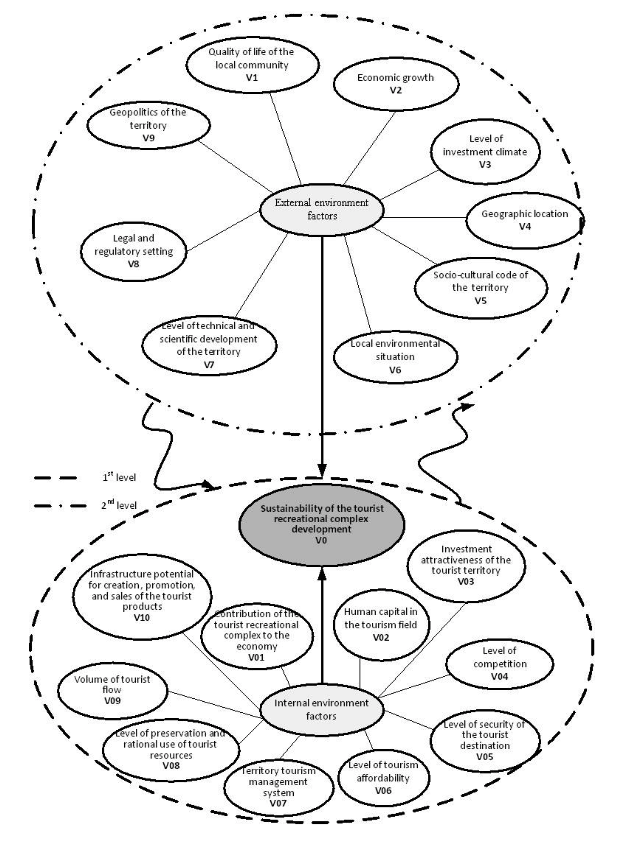
Basing on the obtained representation of the model of interaction between the external and internal environments of the local tourist recreational complex on the path to sustainable development, we can build a cognitive model that is a sign oriented graph (digraph) with many vertices - elements of the system under study and the arcs connecting them that reflect the relationships between the vertices (each relationship can be revealed to the corresponding equation, which can contain both quantitative (measurable) and qualitative (unchanged) variables) (Gorelova, et al, 2006; Gorelova, 2011).
Figure 3 presents an enlarged cognitive model of development of the local tourist recreational complex oriented towards sustainable development built using the software system of cognitive modeling.
Figure 3
Enlarged cognitive model of development of the local tourist recreational complex
oriented towards sustainable development built using the software system of cognitive modeling
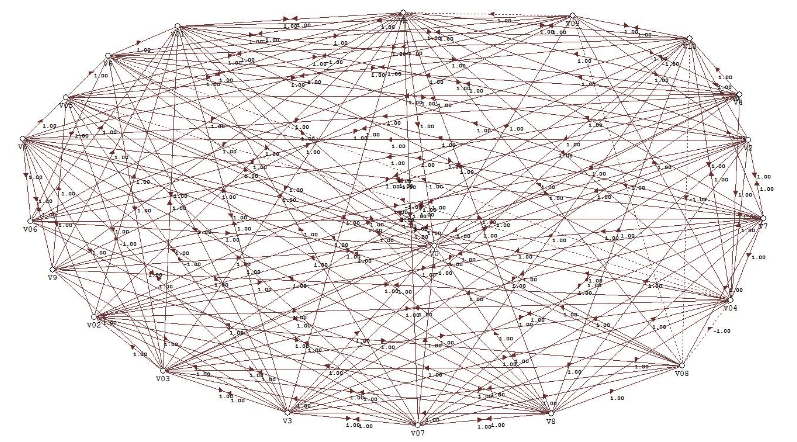
The selection and justification of the system of factors included in the presented model (Fig. 2) are due to the adjacency matrix, which reflects the direction of influence of elements in the studied system obtained on the basis of the application of the expert method. The relationship between the elements can take the value "+1" or "-1" if there is a relationship and "0" if there is no connection between the elements.
The developed cognitive model is close to assessing the prospects of sustainable development of the tourist recreational complex in the system of influence of environmental and internal factors and allows using cognitive analysis technology to study the mutual influence of these factors, and identifying those, whose influence on the sustainable development of the tourist recreational complex is the main one.
Further cognitive research is aimed at exploring the possibility of predicting the situation under study, which will allow us to make effective managerial decisions; including preventing unwanted events or adapting to them, reducing losses. This stage of the research is called scenario research and modeled by impulse processes, which is achieved by introducing impulses (disturbances) to the vertices of the cognitive model - this means a certain change that has occurred at this vertex, actualizing the entire system of indicators - the vertices associated with it, to a greater or lesser extent.
Let us present the possible development of situations in the system using the constructed cognitive model of development of the local tourist recreational complex of the territory oriented towards sustainable development using several constructed scenarios as an example in accordance with the experimental plan (Table 2).
The experiment is based on the implementation of measures provided for in the development of one of the Russian territories – the Krasnodar Region.
Table 2
Computing Experiment Plan
Scenario |
Vertices into which the disturbing impulses are introduced (+1,-1) |
Scenarios in accordance with the strategic goals of the Development Concept of the Krasnodar Region Recreation and Resort Tourist Complex for the period until 2030 and the measures planned for their implementation |
|
Scenario No.1 Creation of a global competitive center for beach and sea recreation provided with landscaped beach areas and modern beach infrastructure in the required volume; become the leading region in beach tourism and children’s vacations in Russia |
V02 (+1)
V03 (+1)
V05 (+1)
V07 (+1)
V08 (+1)
V10 (+1) |
Scenario No.2 Creation of an all-season innovative health center that effectively combines the available balneological and recreational resources, traditional and ultramodern methods and technologies of diagnosis and rehabilitation, providing a high level of medical services |
V02 (+1)
V03 (+1)
V07 (+1)
V08 (+1)
V10 (+1) |
Scenario in accordance with the objectives of the Strategy for Socio-Economic Development of the Krasnodar Region until 2020 as part of the development of the resort and tourist complex |
|
Scenario No.3 Ensuring a fundamental change in the situation at the existing enterprises of the resort and tourist complex and modernization of the management system using the principles of the tourism industry world leaders |
V2 (+1)
V3 (+1)
V7 (+1)
V8 (+1) |
Scenario No.1. In accordance with one of the strategic goals of the Development Concept of the Krasnodar Region Recreation and Resort Tourist Complex for the period until 2030, it is planned to create a “globally competitive center for beach and sea recreation, provided with comfortable beach areas and modern beach infrastructure in the required volume, gaining the position of the leader region in beach tourism and children’s vacations in Russia”. There are measures aimed at building up the infrastructure potential for creating, promoting and selling local tourist products, developing human resources in the tourism sector, increasing the efficiency of the local tourism management system, increasing the level of preservation and rational use of the tourist resources, the safety of tourist destinations and its investment attractiveness.
How will the defined measures, aimed to achieve this goal, affect the sustainable development of the region’s tourism and recreation complex?
As it can be seen from the graph in Fig. 4, the sustainability of the development of the tourist recreational complex will be achieved starting from step 2, however, the local ecological situation demonstrates negative dynamics already in the third step of modeling, which, of course, does not meet the initially established sustainability criteria.
Figure 4
Scenario No.1
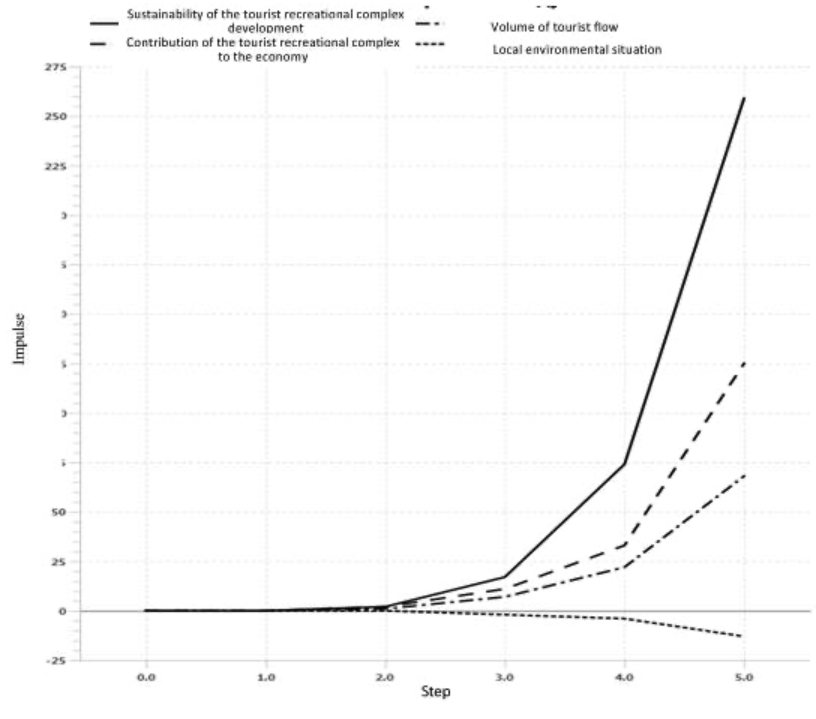
Scenario No.2. In accordance with one of the strategic goals of the Development Concept of the Krasnodar Region Recreation and Resort Tourist Complex for the period until 2030, it is planned to create an “all-season innovative health center that effectively combines the available balneological and recreational resources, traditional and ultramodern methods and technologies of diagnosis and rehabilitation, providing a high level of medical services". There are measures aimed at building up the infrastructure potential for the creation, promotion, and sales of the local tourist products, developing human resources in the tourism sector, increasing the effectiveness of the local tourism management system, increasing the level of preservation and rational use of tourist resources, and its investment attractiveness.
How will the defined measures, aimed to achieve this goal, affect the sustainable development of the region’s tourism and recreation complex?
As it can be seen from the graph in Fig. 5, the sustainability of the development of the tourist recreational complex will be achieved later than the previous scenario showed, and the ecological situation of the territory demonstrates the negative dynamics earlier, which also does not meet the sustainability criteria originally established.
Figure 5
Scenario No.2
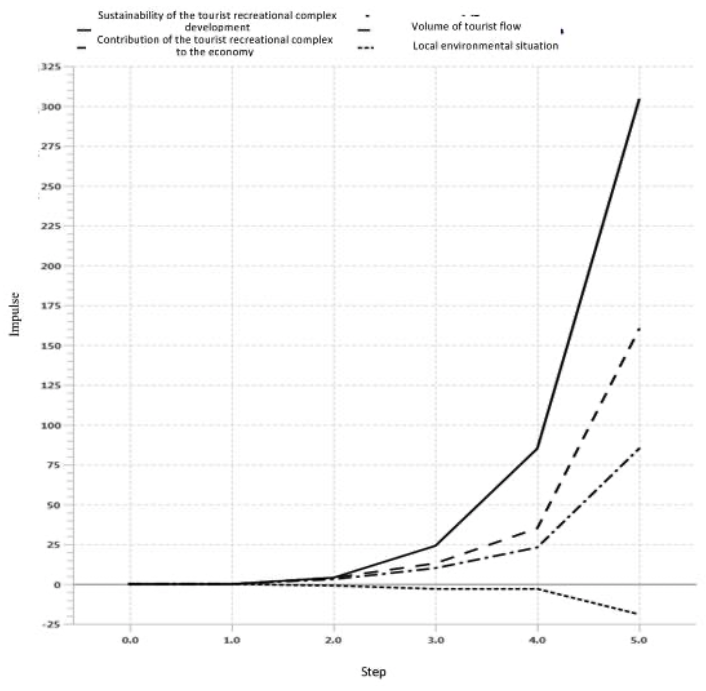
Scenario No.3 In accordance with the Strategy for Socio-Economic Development of the Krasnodar Region until 2020, one of the strategic directions is “ensuring high rates of sustainable regional economic growth through the implementation of the state structural and institutional policy aimed at creating global competitive advantages for the economy of the region”, including doing so through the development of one of the priority complexes – resort and tourist complex. The main strategic actions include the formation of institutional conditions and prerequisites for the sustainable economic growth of the region, the creation of a favorable investment climate, the stimulation of demand for scientific and technical products, new equipment and technologies. Thus, this scenario will allow us to consider the situation in which the external factors have an impact on the sustainable development of the local tourist recreational complex.
Figure 6
Scenario No.3
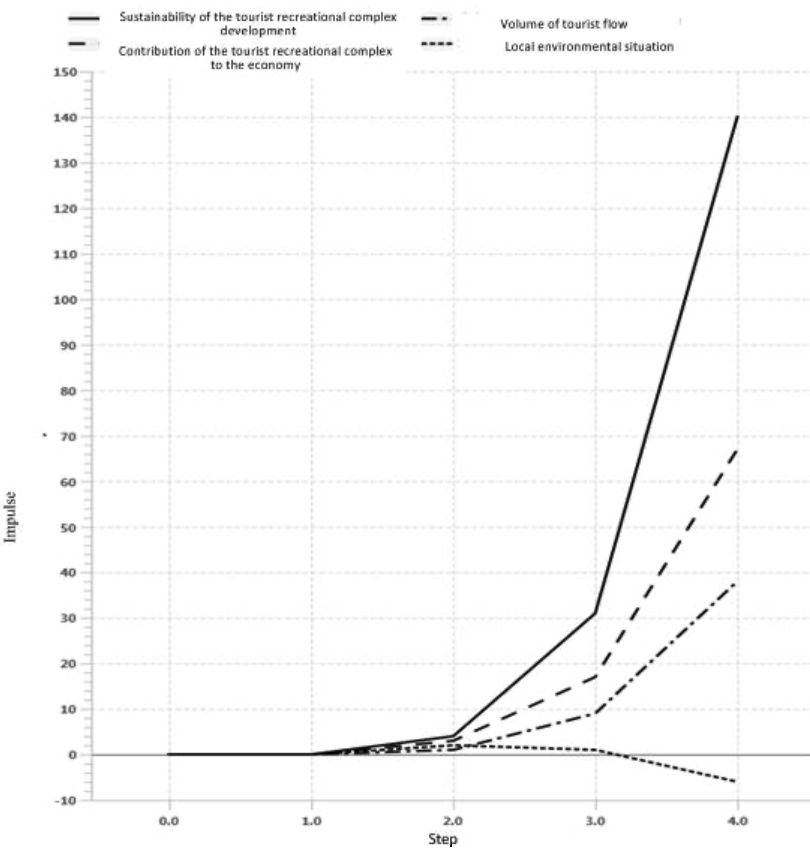
As we can see from the graph in Fig. 6, the sustainability of the development of the tourist recreational complex will be achieved earlier than in Scenario No. 1, so we can talk about the sustainable development of the complex in two modeled steps. There is also no increase in one of the indicators – the “environmental situation”.
As a result, of the three scenarios presented, it is precisely the influence of external factors caused by the measures of the Strategy for Socio-Economic Development of the Krasnodar Region until 2020 that made it possible to ensure sustainable development over a certain period. It should be noted that in this scenario there are planned measures aimed to increase the level of scientific and technical development of this territory. Of course, at present, increasing the efficiency of functioning of both individual industry complexes and entire regions is associated with management approaches that are increasingly based on innovative technological solutions, digitalization and platforming, which can satisfy the needs of all interested participants: residents, business, authorities, etc. Therefore, we can assume that to achieve sustainable development of the tourist recreational complex, as a mandatory factor, we must increase the level of scientific and technological development of the territory.
Among the main results of the study, we highlight the construction of a cognitive model of sustainable development of a local tourist recreational complex and the conduct of cognitive modeling based on impulse modeling, which made it possible to verify the scenarios that are currently being implemented for one of the Russian regions – the Krasnodar Region.
The reported study was funded by RFBR according to the research project No 18-010-00665А\19 “Methodological Approach to the Assessment of the Potential and Forecasting of Development of Tourist and Recreational Clusters in the Conditions of Territorial Differentiation.”
A New Paradigm for the Development of Russia (Complex Problems of Sustainable Development). (2000). Under. ed. V.A. Koptyug, V.M. Matrosov, V.K. Levashov. – Moscow: Publishing. Academy, Publishing House MGUK. ISBN 5-87444-114x
Aigina, E. (2018). Overtourism and Tourismophobia: New Phenomena or Old Problems? Modern Problems of Service and Tourism, 4. Retrieved from URL: https://cyberleninka.ru/article/n/sverhturizm-i-turizmofobiya-novye-yavleniya-ili-starye-problemy. (access date: 29.06.2019).
Baranov, V.V., Matrosov V.M. (1999). The scientific Basis for Decision Support in Security and Sustainable Development. In the Book. “A New Paradagm of Russia's Development (Integrated Studies of Sustainable Development Problems)” / Ed. V.A. Koptyug, V.M. Matrosov, V.K. Levashov M .: - ed. Academia, ed. MGUK.
Barbashin, E. I. (1967). Introduction to the Theory of Stability. – MOSCOW: Nauka.
Bramwell, B., & Lane, B. (1993). Sustainable Tourism: an Evolving Global Approach, Journal of Sustainable Tourism, 1 (1), 1-5.
Briassoulis, H. (2001). Sustainable Development and Its Indicators: Through A Glass Darkly. Journal of Environmental Planning and Management, 44 (3), 409-427.
Butler, R. W. (1998). Sustainable Tourism – Looking Backwards in Order to Progress? In C. M. Hall & A. A. Lew (Eds), Sustainable Tourism: Geographical Perspectives. New York: Addison Wesley Longman ltd, 25-34.
Butler, R. W. (1993). Tourism: an Evolutionary Perspective. In J. G. Nelson, R. Butler & G Wall (Eds), Tourism & Sustainable Development: Monitoring, Planning, & Managing, Dept. of Geography Publication Series. Waterloo: Heritage Resources Centre, University of Waterloo, 26-46.
Casti, J. (1982). Large Systems: Connectivity, Complexity, and Disaster. - Moscow.: Mir.
Cronin, L. (1990). A Strategy for Tourism and Sustainable Developments. World Leisure and Recreation, 32 (3), 12–18.
Development Concept of the Krasnodar Region Recreation and Resort Tourist Complex for the period until 2030.
Gorelova, G.V. (2010). Cognitive Tools for Solving System Tasks of Socio-Economic Objects. Scientific and Practical Conference. System Analysis in the Economy. Moscow: CEMI RAS, 33-45.
Gorelova, G. V. (2011). Cognitive Modeling as the Instrument in Course of Knowledge of Large System. International Journal Information Theories and Applications, Bulgaria, 18 (2), 172-182.
Gorelova, G.V., Zakharova, E.N., Radchenko, S.A. (2006). The Study of Poorly Structured Problems of Socio-Economic Systems: A Cognitive Approach. Rostov-on-Don: Publishing House of Rostov University.
Gorelova, G.V., et al. (2010) Еxperience in Cognitive Modeling of Complex Systems / Cubernetics and systems, Proceedings of the 20-th European Meeting on Cybernetics and Systems Research. – Pr. in Austria, Vienna, 220-223.
Hunter, C. and H. Green (1995). Tourism and Environment, London: Routledge.
Hunter, C. (1995). On the Need to Re-conceptualize Sustainable Tourism Development. Journal of Sustainable Tourism, 3 (3), 155–165.
Indicators of Sustainable Development (Environmental and Economic aspects) (2001). Under. ed. S.N. Bobyleva, P.A. Makeenko – Moscow: CPRP. ISBN 5-87444-114x
Matrosov, V.M. (1999). An Approach to the Analysis of Strategic Stability, Taking into Account Demographic, Military-Political, Medical-Environmental and Economic Factors in A Multipolar World, Using A Computer Model. Moscow: Publishing. Academy, Publishing House MGUK. 298-306.
McCool, S., Butler, R., Buckley, R., Weaver, D., & Wheeller, B. (2013). Is Concept of Sustainability Utopian: Ideally Perfect but Impracticable? Tourism Recreation Research, 38:2, 213–242.
Mowforth, A,. & Munt, I. (1998) Tourism & sustainability: New tourism in the third world. London : Rutledge.
Reid, D. (1995). Sustainable Development: An introductory Guide. London: Earth Scans Publications.
Reid, D. (2003). Tourism, Globalization & Development – Responsible Tourism Planning, Pluto Press, Sterling, VA.
Sustainable Tourism Online. – http://www.sustainabletourismonline.com.
Sharpley, R. (2000). Tourism and Sustainable Development: Exploring the Theoretical Divide, Journal of Sustainable Tourism, Vol. 8, No. 1.
Strategy for Socio-Economic Development of the Krasnodar Region until 2020. (2008) Retrieved from https://krasnodar.ru/ (access date 28.03.2019).
Technical Report by the Bureau of the United Nations Statistical Commission (UNSC) on the Process of the Development of an Indicator Framework for the Goals And Targets of the Post-2015 Development Agenda (Working draft). (2015). Sustainable Development Knowledge Platform. United Nations. Retrieved from https://sustainabledevelopment.un.org/(access date 15.04.2019).
United Nations Conference on Sustainable Development or Rio+20, UNCSD 2012. (2012). Retrieved from http://www.uncsd2012.org/ (access date 15.04.2019).
UNWTO and UNEP (2005) Making Tourism More Sustainable: A Guide for Policy Makers, UNWTO, Madrid and UNEP, Paris
World tourism organization (WTO). (2013). Sustainable Tourism for Development Guidebook. Retrieved from https://sdt.unwto.org/ (access date 15.04.2019).
Yakimenko, M., Zhertovskaja, E., Pshenichnykh, Y., Gorelova, G. (2018). Elaboration of the System of Indicators for the Territorial Tourist Potential Evaluation Based on the Cluster Approach to Tourism Development, Espacios, Vol. 39 (36), P. 15.
Zakharova, E. N., Kerashev, A. A., Gorelova, G. V., Prokhorova, V. V. (2015). Cognitive Russian Modeling in the System of Corporate Governance. Mediterranean Journal of Social Sciences, Rome, Italy, 6 (2), 295-303.
1. PhD in Economic Sciences, Head of the Department of Management Technologies in the Tourism Industry, Southern Federal University, Rostov-on-Don, Russia. Contact email: yakimenko.m@mail.ru
2. PhD in Economic sciences, Assoc. Prof., Department of Management Technologies in the Tourism Industry, Southern Federal University, Rostov-on-Don, Russia. Contact e-mail: jertovskayaev@yandex.ru
3. Professor, Doctor of Engineering, Department of State and Municipal Governance, Southern Federal University, Rostov-on-Don, Russia. Contact email: gorelova-37@mail.ru
[Index]
revistaESPACIOS.com

This work is under a Creative Commons Attribution-
NonCommercial 4.0 International License